#japanese media
Text
"Ossan's Love" Becomes Japan's Number One Friday Night Drama of All Time
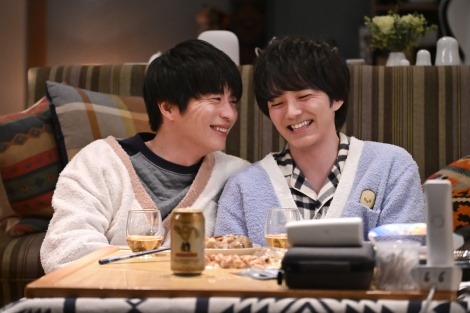
名シーンの連続に、第1~3話とTVerで配信中のスピンオフの見逃し配信総再生数が700万回を突破(※ビデオリサーチにて算出 期間1月6日~24日)するなど、金曜ナイトドラマ枠歴代1位の快進撃となった。
oricon.co.jp
"This series of famous scenes has become the number one Friday night drama of all time, with the total view count of the first three episodes as well as the spin-off episode (available on TVer) surpassing 7 million (calculated by Video Research Ltd. from January 6 to 24)."
The Ossan's Love franchise began in 2016 with a TV movie that earned a small but loyal following that enabled the 2018 series that saw the casting of Hayashi Kento and the introduction of Maki's character. It's his inclusion, the chemistry between him and Tanaka Kei, and the extra work they did on developing nuance in their characters that I think led to the massive popularity of the 2018 drama.
It was only seven episodes, and no one expected it to be popular, but the final episode trended globally at number one on Twitter, which is bananas.
Summer of 2019 saw a movie that continued on from the end of the 2018 version. This was massive. Red carpet event for the premiere, nationwide theaters, merch, and the biggest screen in Roppongi Hills (the one with the fancy armchairs).
Ossan's Love was a massive success.
There was also the plane show in winter of 2019 (without Hayashi). It sure did happen.
The fanbase of the 2018 version (called S1 by the Japanese fandom) is huge and enthusiastic, so it's no surprise to see the success of S2, but to claim the number one Friday night drama of all time!!! For a queer drama!!!
A queer drama just became the number one Friday night drama of all time in Japan, a country that has yet to legalize marriage equality.
Incredible.
#ossan's love#ossan's love returns#makiharu#kento hayashi#tanaka kei#japanese drama#japanese media#lgbtq+#lgbtq#queer media
249 notes
·
View notes
Text
A collection of illustrations of various mythical creatures by the late but nonetheless legendary Shigeru Mizuki
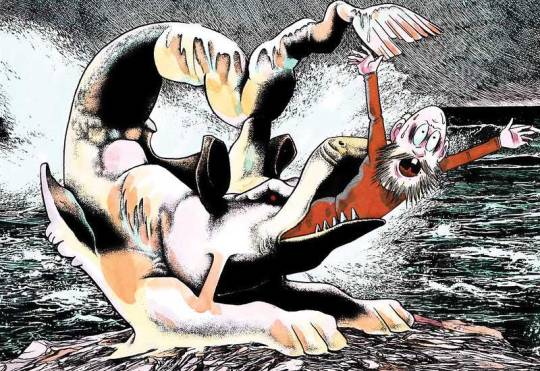

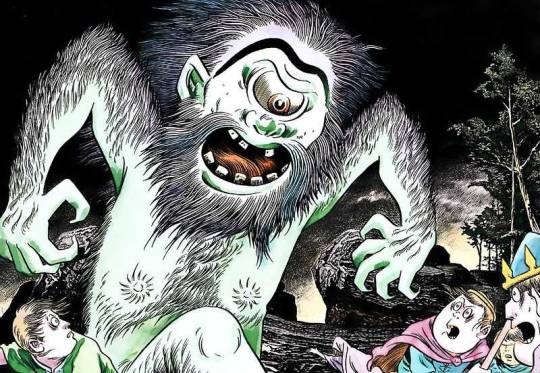


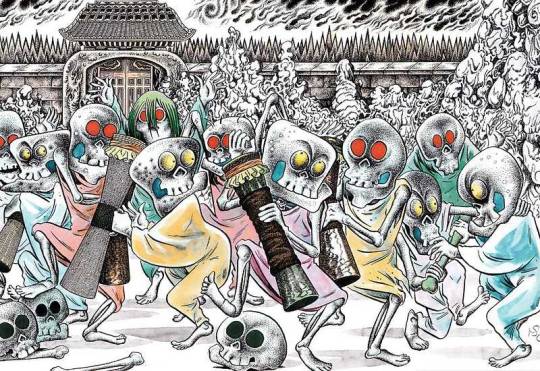
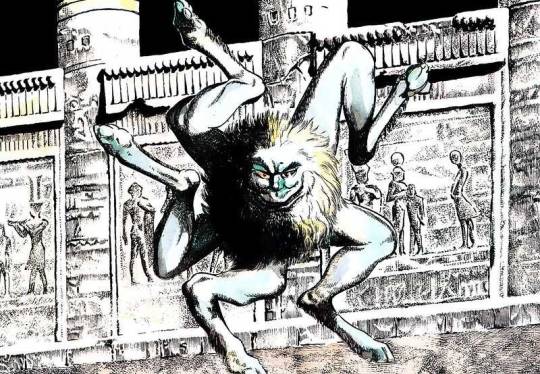
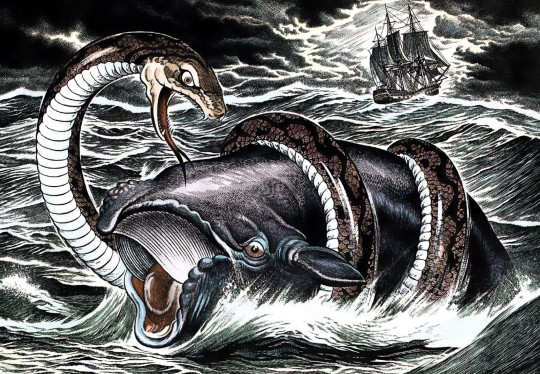


528 notes
·
View notes
Text
The ONLY job I want is one of those office jobs in Japanese media. Nondescript. Homey. Mysterious because what kind of office it is is never said. Kind desk neighbors and an understanding boss. Fun gossip. I want a workplace that's ALL comfy vibes.
#office#office jobs#old fashion cupcake#cherry magic#what did you eat yesterday#kinou nani tabeta#Shiro is a lawyer but he counts#jdrama#manga#anime#my new boss is goofy#those are the only ones I can recall I think#japanese media
65 notes
·
View notes
Text
youtube
New video!
New video! Maruto Fumiaki may best be known now for White Album 2 and SaeKano, but in 2005 he first hit it big with the visual novel Parfait. And today, we're exploring if this classic work about human warmth and love still holds up almost 20 years later.
#visual novel#japanese media#youtube#dating sim#visual novels#parfait#amelie doree#video essay#trans creator#maruto fumiaki#Youtube
57 notes
·
View notes
Text
watching Funny Pets and just remembering how much i am unironically a fan of this guy's work. it really sucks that there isnt more of it out there other than PTP and FP and I've never found anything quite like it.
every. single. time. i'm having a terrible time in life and i remember my comfort show (Popee The Performer, though I occasionally watch Happy Tree Friends too) i watch it and it just.. makes me feel better. it flings me so far out of my usual headspace and away from my problems and instead fills my head with the wonderful, surreal and violently sadistic imagination of Ryuji Masuda. i can never properly give name to the range of indecipherable feelings this guy's work gives me. it's like heroin bro i want to mainline this uglyass cartoon into my veins. i NEED to find more of this DESPERATELY
#popee the performer#funny pets show#funny pets#ryuji masuda#surreal#horror#black comedy#violent cartoons#i love surreal violent cartoons forever and ever#japanese media#ask to tag
21 notes
·
View notes
Text




Harakiri (1962)
#film#film stills#cinema#screencaps#classic cinema#japanese film#japanese cinema#japanese media#Harakiri 1962#samurai films#samurai#masaki kobayashi
20 notes
·
View notes
Text
Japanese Media that Helped Me Come Out
Hey, I wanted to make a post about the shows and movies from Japan that really helped me come to terms with my identity and made me more comfortable with coming out (even if I had a few early aborted comings out before I had real support).
Before I begin, a special shoutout has to be given to Ranma 1/2, the first anime I ever saw that involved gender changing content.

I think one of the first foundationally important bits of media for me was Sailor Moon, the original animated series. Or more specifically season 5, Bishouji Senshi Sailor Moon Sailor Stars. This is a series I watched shortly after the episodes aired in four episode blocks at a time on rented VHS tapes from a local Japanese Electronics Store in Dallas, Texas. (R.I.P. Orbit Electronics).
For those not familiar with the series, this season introduces three major new heroic characters, the Sailor Starlights. In their civilian identities they are a boys idol group called The Three Lights and go by the names Seiya, Yaten and Taiki but in their heroic identities they are three women named Sailor Star Fighter, Sailor Star Healer and Sailor Star Maker.
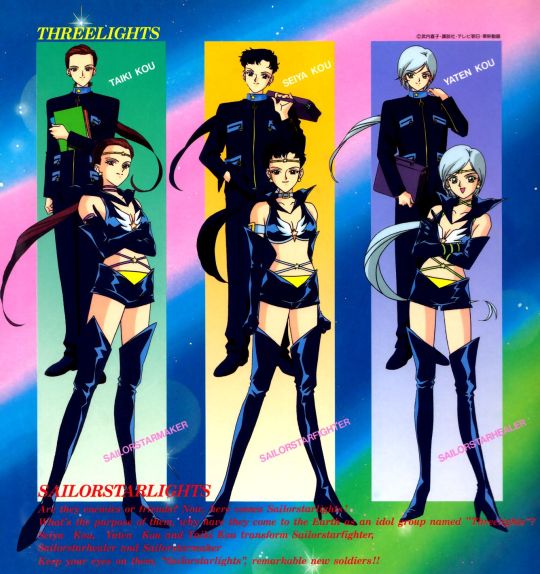
The idea of three women hiding themselves in the guise of men was so fascinating to me and spoke to something deep down inside of me. This may be the reason why Sailor Stars is the series I decided to purchase on Laserdisc back when it was coming out.

The second major anime series from this time that was foundational for my exploration of who I am was 1997's Shoujo Kakumei Utena.
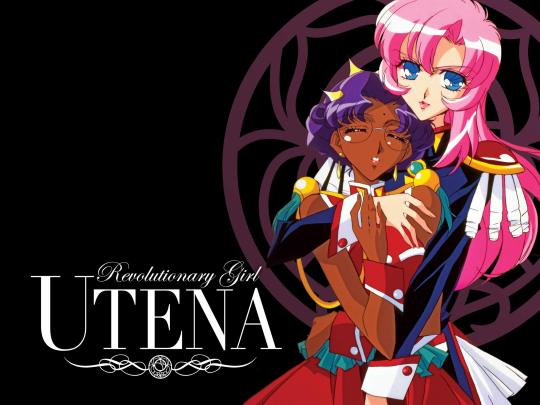
This is a series all about defying societal expectations especially of gender roles and sexuality. It's an amazing if sometimes very couched in metaphor and symbolism coming of age story about a young woman who refuses to conform to her expected role and seeks to become a Prince to defend others.
It also contains dialogue like this:

Which, if you are familiar with Trans terminology just holds so much extra meaning. For those who do not know, trans people who have not come out yet are often referred to as eggs, as in they have not come out of their shell yet.
Lastly is probably both the most obvious and most ridiculous entry here. the 1999 Rock and Roll, Zombie, Alien Invasion film Wild Zero.
This is a movie about the rock band Guitar Wolf, their biggest fan Ace and a zombie apocalypse started by aliens (think Plan 9 from Outer Space but somehow even more wild and ridiculous and with an amazing soundtrack).
In the movie, Ace meets and falls in love with a beautiful girl named Tobio.
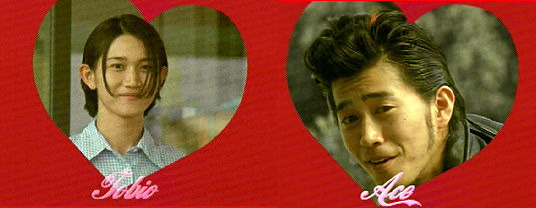
However, as Ace discovers, Tobio has a penis. This causes him to have a bit of a crisis until his idol, Guitar Wolf appears before him in a bathroom to bestow these words of wisdom upon him.

So yeah, this movie helped me in some very strange ways when it came to accepting who I really am, even if it took YEARS for me to finally crack my shell for real and come out publicly.
So, thanks for reading this and thanks for all of your support.
#Coming Out#Japanese Media#Anime#Horror#Rock n Roll#Ranma 1/2#Sailor Moon Sailor Stars#shoujo kakumei utena#Wild Zero#Trans#Transgender#Guitar Wolf
132 notes
·
View notes
Text
Omg. Perfect Propose. My heart. What a lovely little series. Highly recommend.
14 notes
·
View notes
Text
Hey, I have a question for the cultural side of tumblr.
In Japanese media, it seems like cults are associated with selling expensive vases. While I get that it's to scam people by selling them overpriced crap, why are vases part of the stereotype? Is there a historical reason behind this?
For example, in chapter 58 of Noragami, there's this dude. The shorthand for him being in a cult (besides his name) is that he's smiling while holding a vase that says "Happiness." The implication is that the cult promised him that the vase would bring him happiness, and he fell for it.
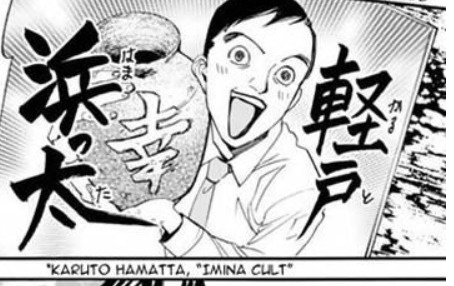
I remember seeing something similar in Zelda: Spirit Tracks, where the well-respected elder and fortune teller tells you that you're being haunted by an evil spirit. She tells you to buy a very fragile vase for 10,000 rupees, quickly dropping the price to something reasonable. Is this also a scam, or was the vase meant to be genuine? (For what it's worth, the vase ends up being used just as decoration).
In Persona 5, there seems to be a similar principle without vases. One Confidant involves a cult that sells Holy Stones (i.e. rock salt) that can supposedly change fate, for 100,000 yen (approx. 1000 USD) apiece, and members are roped into selling these to passerby.
So why vases? Is it because it's easy to make cheap vases that look expensive? I've heard they're a status symbol. Is there some kind of cultural association with them? Did someone try this IRL?
#cultural side of tumblr#science side of tumblr#japanese culture#japanese media#cults#noragami#spirit tracks#persona 5#scams#cult#japan#scam cults
46 notes
·
View notes
Note
Hey. There was a new Raincode interview written a few days ago and in that interview, Halara’s gender was brought up. I made a post about that question on my blog and I am curious your thoughts about it. I also linked the interview in my post.
(This is the post in question, for anyone interested. Which I think you probably should be, but... )
My thoughts are mostly that Kodaka's quote/response feels frustratingly uninformative and devoid of any value, but also sadly unsurprising. I know it's just a machine translation, so maybe this isn't capturing the exact nuance of the statement... but the sentence "I didn't specifically intend a social message" is just exactly the kind of vague, wishy-washy, "I really don't want to be in trouble with or offend anyone on any side of any possible argument" language that I've LONG gotten used to in promotional interviews about movies, TV, books, games, etc. Because god forbid you possibly appear to be either for or against anything that might be considered controversial in any possible market! Having STANCES on THINGS could damage your profit margin with some potential demographic.
I suppose this could be all there is to it. Maybe Kodaka legitimately means what he says here and put no greater thought into Halara's lack of gender identity. But I also think it'd be weird if the implications of leaving their gender unknown didn't at least occur to him at some point, particularly as there's been a growing awareness of so-called "X-gender" people in Japan over the last year and a half.
But ultimately, "Master Detective Archives: Rain Code" is Japanese media, and that leaves this kind of question-dodging not only expected, but arguably maybe even necessary. Take a look at the recent of the recent controversy over The Witch From Mercury, the Gundham anime that is over-the-top mega-gay. Bandai Namco still felt the need to declare that the relationship between Suletta and Miorine is "open to interpretation" despite the fact that the two get FUCKED MARRIED.
In fact, this Kotaku article does a good job digging into not only that anime's particular can of worms, but also how queer-friendly media in Japan continues to be suppressed and censored from the dominant conservatives behind the media companies and government even while those works enjoy massive popularity with younger consumers. Get a load of what they say about Yuri! on Ice:
Look no further than the fate of 2016’s smash hit Yuri! On Ice, which tells the tale of a struggling figure skater, Yuri Katsuki, who is coached back to success by the charismatic and undeniably handsome Victor Nikiforov. Similar to The Witch From Mercury, the pair’s relationship is explicitly laid out in the story, and the characters also exchange rings. It was, and still is, celebrated as a landmark anime for LGBTQ+ representation. It received acclaim in Japan, winning Animation of the Year at the Tokyo Anime Awards as well as a number of fan-voted awards. It has consistently been named as one of the top anime of the 2010s by IGN, Anime News Network, and here at Kotaku.
In what seemed like an obvious move to capitalize on the success of the show, a feature-length Yuri! On Ice movie was greenlit almost immediately. But six years later, a statement from Studio MAPPA CEO Manabu Otsuka said that despite the show being a hit, the company didn’t make a lot of money off of Yuri! On Ice, and as such, the movie likely won’t happen.
Back when Blu-ray sales mattered to the anime industry, Yuri! On Ice torched the competition, selling nearly double the amount of discs of its nearest competitor, the juggernaut franchise Love Live. The runaway success of Yuri! On Ice led to MAPPA’s heightened profile in the industry, which helped it secure the rights to produce Attack on Titan’s never-ending final season, the massively popular Jujutsu Kaisen, and the second season of Makoto Yukimura’s viking masterpiece, Vinland Saga. For MAPPA to claim that the Yuri! On Ice movie isn’t financially viable is disingenuous and contradicts standard industry metrics for success. MAPPA could release the Yuri! On Ice movie tomorrow, and it would be a guaranteed hit. Which begs the question, what is the hold up?
It's a reminder that speaking out against the anime production committees that dole out the work to animation studios is a dangerous game. In most of her press for Yuri! On Ice, creator and director Sayo Yamamoto played nice, answering softball questions that never directly addressed the very obvious love playing out on screen between Yuki and Victor. But, in the Yuri! On Ice fanbook “Go Yuri Go!” from 2017, Yamamoto claimed that the series had been censored outside of her control, and she had to fight to keep a kiss between Yuri and Victor in the final cut of the show.
Since then, Yamamoto has not gotten any other projects. To have arguably the biggest hit of 2016, receive critical acclaim from your own industry, and then not be given any work? It doesn’t add up. MAPPA has tied Yamamoto to the Yuri! On Ice movie project and essentially strung her out for six years now, leaving her in a kind of professional purgatory.
In an industry where the slightest scandal can lead to blacklisting, the idea that Yamamoto is being punished for wanting to go all-in on a queer narrative is not far-fetched.
So. Yeah. This is all a very long way of me saying "I don't know whether what Kodaka said here really tells us much about his intentions/thoughts, nor do I expect we'll ever hear much more on the topic." A lot of Japanese creators have gone the way of just letting the work speak for itself and vaguely denying anything else in public, because it's just safer that way... even if it leaves the rest of us clueless as to where the legit allies are.
Either way, Halara is a pretty awesome representation regardless. I'll just take that as a positive sign.
#japanese media#asks#kazutaka kodaka#master detective archives: rain code#rain code#master detective archives#the witch from mercury#yuri! on ice#queer media
31 notes
·
View notes
Text
Those weird mangas: Katsuhiro's Hansel and Gretel
Some times ago I made a post about a not-so-well-known horror anime about fairytales, Otona no Douwa. I translated a French review of this hard-to-get series (and you can find here, here and here). Today I want to continue my dive into the weird world of fairytale mangas (because Japanese mangakas LOVE fairytales), with a work by Otomo Katsuhiro.
Otomo Katsuhiro is one of those giants of the manga, most famous for the classic that is Akira. But few people know that before he gained his great fame, he did a lot of humoristic mangas parodying classics of folktales and literature. Among those early works, can be found one of the "bizarre fairytale mangas": his "Hensel to Gretel", or "Hansel and Gretel".

This anthology is a series of short parodies of fairytales or literary works. All short, holding on a few pages, except for the very first story, Hansel and Gretel, that is the opening story and the longest of the collection, but holds within it all that the rest of the book has to offer. (In fact, I might do an analysis of the Hansel and Gretel chapter later).
As reviewers pointed out, Otomo Katsuhiro was still searching and developing his artstyle there, and the heavy influences of the European BD artist Moebius can be strongly seen. The book is apparently quite rare today, as it has gone out of print and never was translated officially - but second hand issues can still be found on the Internet in Japanese, and fan-translations are shared around.
For someone who first stumbles upon this book without knowing what it is about, massive confusion is expected - but in truth there is a logic behind the nonsense.
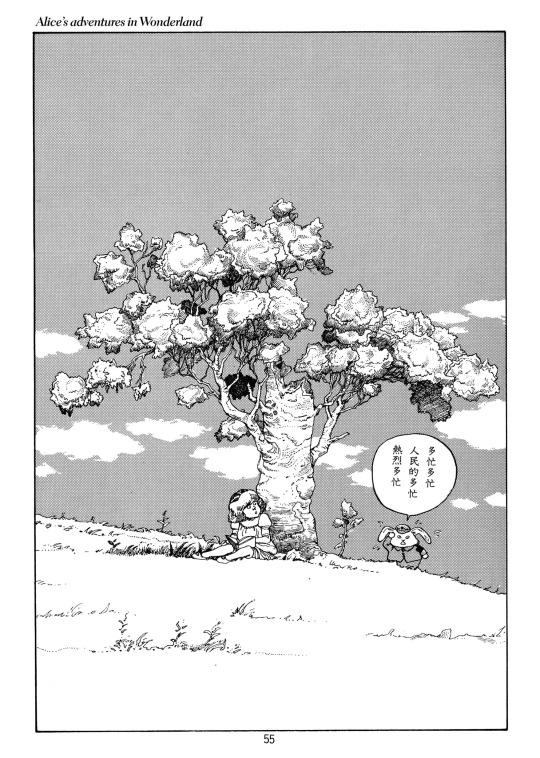
If you ask me, this anthology is quite uneven in quality as some stories work very well while others fall flat (from the Wolf Man story, which is... oversimple ; to the Wizard of Oz story which is just one of those badly handled typical Japanese grotesque sex comedy). Others truly are funny - I never could imagine The Little Match Girl could have a sad yet hilarious ending, and yet it has.
But overall, looking at the various stories, we can clearly identify and point out what the mangaka was trying to do here. On one side, there is an exploration of a typically Japanese absurd humor - such as the "Ali Baba" story which has some unexpected consequences when the password used is "eggplant" ; or an exploration of what happens when in "Snow-White" people find themselves unable to pronounce, understand or remember the number "seven". On the other side, there is an effort to introduce a senseless but realistic cruelty to the world of classics. Don Quixote, in his attempt to become a dragon-slayer in a post-apocalyptic world where the majestic titans are long gone, ends up satisfied with killing a newborn baby ; while the two birds that go searching for the Blue Bird of Happiness end up finding it... and eating it to be happy.
Other times, the mangaka mocks the so-called "heroes" and "protagonists" of various classical works, pointing out their actual absurdity and madness. From Achab going into poetic and over-dramatic hysterics while Moby Dick has a peaceful family reunion with her next of kin, to Robinson Crusoe clearly shown as being an idiotic colonizer and useless tyrant when the island he finds himself on is actually inhabited by dozen of people... And when classical fairytales are presented, the mangaka does the unique but very revealing choice to focus on... the uninteresting, the boring, the unflattering parts. We have a Sleeping Beauty... But it is just her sleeping and nothing happening, since we are in the middle of her hundred years of sleep. We have a Cinderella... But all we see is her fleeing the castle and de-transforming into a dirty cinder-girl dragged in the streets by pigs, while all the drunkards and inhabitants of the city complain about the racket she does at night.
Overall, the entire concept of this anthology could be taken as a desacralization of the classics. Turning funny or innocent stories into cruel and dirty ones ; highlighting the uselesness and madness of famous fictional protagonists, taking more care to focus on the parts of the legends that are usually overseen or uninteresting - and this process all culminates in a complete and humoristically blasphemous reversal of Jesus life, showing him not as the Christ, but as a monstrous Antichrist living in a world that seems to habe been painted by Bruegel and Bosch - a fitting conclusion for an anthology whose entire point is to take beloeved stories, and show that, deep down, they are absurd, vulgar or boring things about caricatural or insane characters.
But the whole thing keeps humor and joke all throughout clearly showing that these are supposed to be "loving" parodies and "kind" mockery, not an actual criticism of the source material - it is a work of dark humor, absurd humor, using rationalization and real-world logic to break down the marvelous, making the wonder mundane, and showing what cartoon violence really looks like.
I do believe this work probably won't please everybody and would be a hit-or-miss, a "I love it all" or "I hate it all". But it stays a very interesting UFO in the world of fairytale adaptations, and an example of what "fairytale experimentations" can look like.

#dark fairytale#fairytales with a twist#hansel and gretel#otomo katsuhiro#katsuhiro otomo#absurd fairytales#japanese media#fairytale parody#manga
9 notes
·
View notes
Text
[Content Warning: sexual assault of minors]
There’s a documentary airing tomorrow on BBC2 about the late Johnny Kitagawa and the very open secret of the many sexual assault allegations against him.

For the uninitiated, Johnny was the founder and CEO of what I believe has been the most powerful music agency in Japan’s history. After founding the agency in 1962, Johnny and his sister Mary are known to have pulled a lot of questionable and downright abusive tactics to gain the amount of power J&A has enjoyed over the Japanese media industry.
Since their influence has been waning over the past decade or so, it’s difficult to explain concisely how strong they were, especially in the nineties and early aughts.
Like, companies were forbidden from using the idols’ images without express permission, so magazines would need to publish previews for upcoming issues featuring blacked-out silhouettes of the idols.

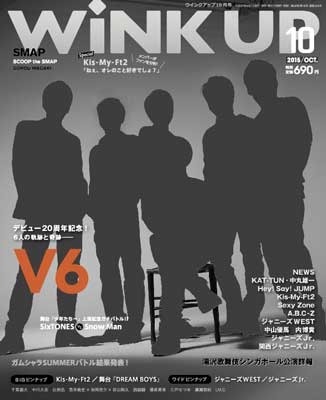
The point was to make J&A idols seem more exclusive and distant to augment their appeal, so only when the magazine was officially released were their images uncensored.


And of course, forever looming in the background were the ever-present allegations of sexual abuse by Johnny himself.
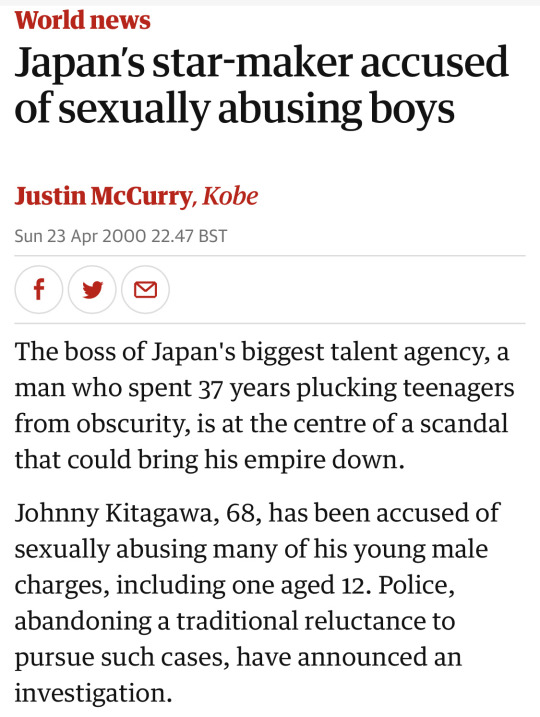
This isn’t in question, either. When detailed testaments from teenage boys were gathered and published in a massive expose by a well-known tabloid back in 1999, Johnny sued for defamation of character. Some of the charges—that J&A supplied minors with alcohol and drugs—were dropped. But the court found legitimacy in the sexual abuse charges. (The transcript is available in Japanese online somewhere, but I can’t remember where off the top of my head. I don’t remember if it was ever translated into English, but I’ll come back with a link if I find it.)

[Variety] Johnny Kitagawa: Power, Abuse, and the Japanese Omerta by Mark Schilling
Regardless, an official charge was never made, the public and fandom overlooked this open secret, and Johnny himself continued to live a wealthy and relatively secretive life behind the wall of his talents’ fame until his death in 2019 at the age of 87.
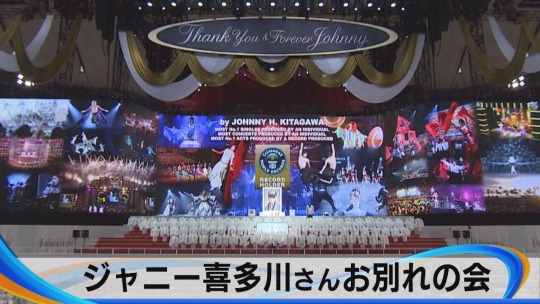
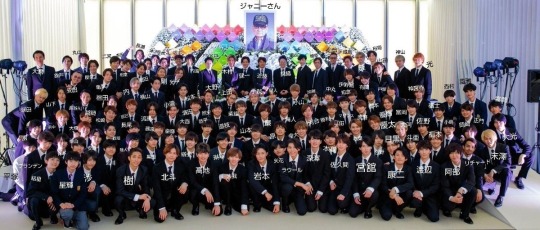
If you’re getting cult vibes from this, you’re drawing some sound conclusions
As an American fan who was once deep in the J&A fandoms of Tackey & Tsubasa, NEWS, Kanjani8, V6, KinKi Kids, etc.…this was a wild place to be in many ways.
From the outside, it’s probably simple enough to look at the facts and understand how clear-cut this is. Fans weren’t ignorant, either, and there was a persistent moral issue in supporting beloved idols while knowing that it led to a known abuser at the top.
And of course, not everyone believed or believes the allegations. Even if tomorrow’s documentary proves without doubt that Johnny Kitagawa sexually assaulted the children and teenagers under his power, there will always be defenders among the fanbase. At the lowest tier of morality, there will always be people whose personal comfort comes first, and rape is a big ole sad face threatening to ruin the flawless facade of Silly Handsome Rainbow Concert Land.
That said, I think what complicated things for a wide swath of the fanbase who did believe the allegations was how affectionately the idols themselves used to and still talk about Johnny. The man’s image for most fans was of an eccentric old man who had an acerbic sense of humor and spoke in random English snippets. “Did you see him?” an idol once asked the audience during a concert. “He was visiting backstage and said, ‘It’s hot out there today. They must be hot, those poor fans outside.’ So he took a box of bottled water and went to hand out waters to people.” Some fans exclaimed in recognition, and the idol laughed and said, “Someone remembers!” Because Johnny himself rarely appeared for interviews and released photos of himself only once every thousand years, the ongoing joke was that hardly anyone among the general public would have recognized this random old man as the mighty mogul of the music world. And because the idols themselves told such quirky stories, many fans chose to take the word of the idols they admired rather than confront the reality in newspapers.
While I lived in Japan, I rarely heard the allegations discussed, and whenever I brought it up among Japanese fans, the atmosphere got awkward and quiet until someone changed the subject. Worse was when I discussed it with members of the general public, many of whom seemed overwhelmingly aware but dismissive. “He’s a weird guy,” an older man once told me wryly. “Everyone knows he’s gay. That’s what they do.”
The subject of Johnny Kitagawa’s abuse is such a wide-reaching and nuanced subject, there’s no way the BBC documentary will be able to introduce Japan’s media culture, the entire J&A system, and the depth of Johnny’s abuse in an hour. But I’m relieved that it’s happening at all because for so, so long, the Japanese media has been unwilling to lose the money-making factory that is J&A by shining a spotlight on Johnny’s crimes, and so the victims of his abuse have been either ignored or reviled.
The thing to remember, I think, is the thing I keep coming back to. The vast majority of these idols joined J&A very young, and many of the older members in their twenties, thirties, and up have no other job experience to this day. Most have no university degree, and some never graduated or even attended high school. This is all some of them have, all they’ve ever had, and the sheer fear of needing to go into the job market at sixteen with nothing on your resume but junior high and “danced behind famous people for three years” in a country as stringent as Japan is unimaginable to me.

(TV Guide’s June 2000 cover featuring the Golden Era of Johnny’s Juniors, most of whom worked so extensively that they were unable to graduate high school or university. In more recent years, the agency has put stronger emphasis on Juniors pursuing their education.)
I don’t follow J&A idols anymore, but I imagine it’s less common today for someone to casually explain that he joined the agency at twelve to help support his struggling single mother and siblings. One of the saddest things I’ve ever heard Takizawa Hideaki say was how happy he was at fourteen when he realized he was among other boys whose fathers had abandoned their families. He grew up in poverty and joined J&A at thirteen, and if I start talking about his history with the agency I’ll never stop. (Thankfully, he and most of his generation have left the agency since Johnny’s death and are pursuing their own paths—though none that I’m aware of have spoken ill of their former boss.)
In the nineties, Juniors slept in two dormitories. Dormitory A was where the Juniors guaranteed to debut slept, and boys in Dormitory B knew it. The most famous boys living in the Kanto region—Takki, Tsubasa, Arashi, Yamapi, etc.—all lived in Dormitory A. After Shukan Bunshun published their expose, the dormitories were permanently closed down.
There’s no way to know what the silenced survivors have been through psychologically. Johnny himself is dead, so closure has to come from allowing the survivors heal however they need to. Japan is notoriously lacking in mental healthcare or awareness let alone compassion for sexual abuse survivors, so perhaps addressing that is the first step so they can find that closure privately.
In any case, the documentary airs tomorrow on BBC2, and I’ll be watching and hoping this is the first step in exposing the crimes committed and opening compassion for the survivors.
24 notes
·
View notes
Text

#original post#chainsaw man#chainsaw man (2018)#funny#meme#chainsaw man meme#impact font#anime#manga#horror anime#horror manga#horror#japanese media#denji#denji chainsaw man#tatsuki fujimoto#horror community#anime community#manga community#chainsaw devil
53 notes
·
View notes
Text
NEW SONG!!! From rito and AI!!! (former members of gulu gulu). (~▽~@)♪♪♪
youtube

Please support them and their youtube page!
Пожалуйста, поддержите их и их страницу на YouTube!
#gulu gulu#vkei#v系#japanese fashion#visual kei#jrock#the gazette#rito gulu gulu#i gulu gulu#x japan#dir en grey#ぐるぐる#i want moots#japanese media#japanese rock#Youtube#ai gulu gulu#madmans esprit#vkeistyle
10 notes
·
View notes
Note
I know this is probably a lot to type, but can you give a brief idea of what your Japanese learning journey was/is like?? Thank you!
Ooooohhh okay okay so
-- tried to learn first in 2016 using Genki I & II and I totally bombed it.
-- picked up again in 2018, failed again
-- in 2021, I realized maybe I should do something different, so I chose to primarily use Cure Dolly's video series for grammar and learning, alongside Genki with Tokini Andy's videos and Anki with Core 2k.
- I eventually dropped Tokini Andy's videos a few months in, same with Anki. I kept up with Cure Dolly's corpse allllll the way to the end though, and replaced time I'd spend with Andy's videos and Anki with reading VNs in Japanese.
- my first VN in JP was Doukyuusei, then Isaku, and then I forget what next. Maybe Rance 03? But I read all of them with the help of a texthooker program and Nazeka as a mouse over dictionary.
I think if I started now, I'd say watch Cure Dolly's course, and once you have basic grammars down, watch some shows with simple vocabulary and grammar like a Precure or Cardcaptor, and also read a VN. Just grind out even when it's super hard in the early days. Don't bother with textbooks or Anki, they don't help much at all IMO. But that's just my two cents.
Hope that helps and ty for asking!! Some day I wanna make a more detailed video, ehehe
66 notes
·
View notes